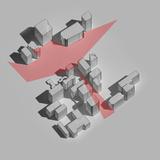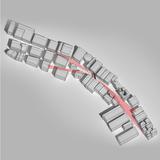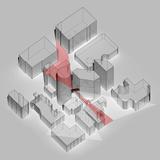
Verified View
Mohammad Momenabadi; advised by Jonathan Bachrach, Sara Dean, Etienne Turpin, and Kyle Steinfeld

Computation requires rigor. Code either compiles or it does not. While not all computations display fidelity with the world they might seek to represent, computability implies a certain degree of rigor, an adherence to an internal logic. In this sense, computation offers architectural designers two important tools: an instrument to verify their expectations of the performance of a design, and a means by which to explore the natural results of a set of first principles. This thesis seeks to detail the application of both these tools, using the theme of vision as a testbed.
The visual experience of space is explored through two proposals: a corporate headquarters and a series of 'skybridge' connections between office towers in three cities. In each, a basic spatial logic is established based upon lines of sight, and generative of architectural form. Then, using the well-established ray-tracing techniques that underlie modern rendering engines, simulations of the visual character of these spaces are conducted to verify desired performances.
CCTV equipment in my project is a tool which has the capability of observing several points or area from a central point. CCTV with its monitoring feature has made an eye which could be everywhere in a very short time, a fluid eye everywhere. Architecture prepares the context for fluid eyes.
The consolidation of potential energy into a small act can have more impact than a large movement. In my architecture, an small area in itself has the most energy in terms of eye contact and visual interaction with environment. This space play a pivotal role in inter-action and as a attraction point.
In this object, the diagram of the camera is open and after a while it depicts a line which consists of a large number of points. There is no dash-line. There is nothing to hinder line to continue its way. Transparency brings about a continuous visual access in architecture without any blocks. An architecture without solid walls.
The quality of glass is resulted by the features of producing glass by roller plate. Any change in the thickness, flatness, and transparency brings about a change in visuality through glass. Architecture can change its result by changing the way it produces the space.
Brain assesses the relative distances of various objects from the viewer, and the depth dimension of those same perceived objects. Stereogram changes the perception of environment in an unusual way. Architecture in its its boundary could absorb attention through this change in the way of seeing around.
Virtual Reality as immerse multimedia is a computer-simulated environment that can simulate physical presence in places in the real world or imagined worlds. In my architecture, Virtual reality can recreate a sensory experience like virtual sight. As virtual eyes engage people in virtual places, virtual architecture could adapt itself with environment.














There's more!
Some other projects from this same class have been posted, as well as some interesting student work from this same year.